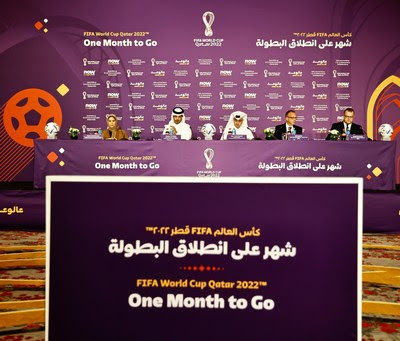الإعلان عن بيع قرابة 3 ملايين تذكرة لحضور مباريات المونديال
الدوحة – قطر17 أكتوبر / تشرين أول 2022/PRNewswire/ — قبيل بدء العد التنازلي لشهر واحد على انطلاق منافسات كأس العالم FIFA قطر 2022 

وخلال مؤتمر صحفي عُقد اليوم في الدوحة؛ أشار منظمو المونديال إلى توفير 30 ألف غرفة إضافية لزوار قطر خلال البطولة المرتقبة ، وتتوفر المجموعة الأوسع من خيارات الإقامة على بوابة قطر لأماكن الإقامة ، وبأسعار تبدأ من 80 دولار لليلة الواحدة للفرد في غرفة مزدوجة، وتشمل الفنادق والشقق وقرى المشجعين وغيرها.
وفي رسالة مسجلة عبر الفيديو، قال السيد جياني إنفانتينو، رئيس الاتحاد الدولي لكرة القدم (الفيفا): “أكدنا دائماً أن قطر ستقدم أفضل نسخة على الإطلاق من بطولة كأس العالم. وكما تشاهدون ما حققته قطر من إنجازات في كافة أنحاء البلاد، من استادات وملاعب تدريب حديثة، وشبكة متطورة من خطوط المترو، وبنية تحتية مشيدة وفق أعلى المواصفات، إن دولة قطر على أتم الاستعداد للترحيب بالجميع، والعالم متحمس لبطولة استثنائية. قطر جاهزة لاستضافة مبهرة، سننظم أفضل نسخة من كأس عالم، تشهد منافسات مشوقة داخل الاستادات، وفعاليات ترفيهية رائعة تقام على هامش البطولة”.
وقال منظمو المونديال إن مبيعات التذاكر وصلت إلى مليونين و890 ألف تذكرة لحضور مباريات البطولة الأربعة والستين، والتي تستضيفها ثمانية استادات مشيدة وفقاً لأرقى المعايير العالمية. وقد تصدّر المشجعون في قطر والولايات المتحدة الأمريكية و السعودية وإنجلترا والمكسيك والإمارات والأرجنتين وفرنسا والبرازيل وألمانيا، قائمة الدول الأكثر حصولاً على تذاكر البطولة . كما سجّل مونديال قطر رقماً قياسياً في مبيعات تذاكر الضيافة. وصرح منظمو كأس العالم أن طرح التذاكر سيتواصل لجميع مباريات البطولة حتى انتهاء منافساتها في 18 ديسمبر المقبل، مع دعوة المشجعين لزيارة الموقع الإلكتروني: FIFA.com/tickets ، للتعرف على المستجدات حول المتوفر من التذاكر.
وسيتلقى حاملو التذاكر بداية من الأسبوع الجاري، رسالة عبر البريد الإلكتروني تحتوي على معلومات حول كيفية تنزيل التطبيق الخاص بالتذاكر على الهواتف المحمولة، والحصول على نسخة رقمية من تذاكرهم.
ودعا المشاركون في المؤتمر المشجعين إلى المسارعة بتقديم طلباتهم للحصول على بطاقة ” هيّا ” الإلزامية، وحجز أماكن الإقامة في أقرب وقت ممكن، وتعد بطاقة هيّا بمثابة تصريح لدخول قطر للمشجعين القادمين من خارجها، كما تتيح لحاملها استخدام المواصلات العامة بالمجان، وتسمح للمشجعين من حاملي تذاكر المباريات بالدخول إلى استادات البطولة.
وأكد المهندس ياسر الجمال، المدير العام للجنة العليا للمشاريع والإرث، أ ن قطر على جاهزية تامة لاستضافة نسخة فريدة من البطولة العالمية، بعد أكثر من عشرة أعوام من العمل الجاد، والتعاون الوثيق مع الشركاء في أنحاء البلاد.
وأضاف: “تمتاز بطولة كأس العالم 2022 بتقارب المسافات، حيث تقع منشآت ومرافق البطولة ضمن نطاق جغرافي محدود، ما يتيح للمشجعين واللاعبين البقاء دائماً في موقع الحدث، وعلى مقربة من الاستادات المونديالية والأماكن التي ستشهد الأنشطة الترفيهية. ونتطلع إلى استضافة بطولة استثنائية تبقى خالدة في ذاكرة المشجعين من أنحاء العالم “.
من جانبه، قال السيد ناصر الخاطر، الرئيس التنفيذي لبطولة كأس العالم FIFA قطر 2022
وقال السيد كولين سميث، المدير التنفيذي لعمليات كأس العالم في الاتحاد الدولي لكرة القدم (الفيفا): “تضمن الطبيعة متقاربة المسافات في قطر تشغيل أكثر من 168 موقعاً رسمياً خلال البطولة المرتقبة، وتقع جميعها ضمن مساحة محدودة، ويحمل كل من هذه المواقع أهمية خاصة للاستضافة الناجحة للمونديال. وإلى جانب نجاحنا في اختبار جاهزية استادات المونديال الثمانية؛ بدأنا في تشغيل مراكز المتطوعين وإصدار التصاريح، ومن المقرر افتتاح مركز بيع تذاكر المباريات غداً في مركز الدوحة للمؤتمرات والمعارض، على أن يلي ذلك مركز البث الدولي، والمركز الإعلامي الرئيسي.”
وأضاف سميث: “لا يسعني إلا أن أؤكد مجدداً ثقة الفيفا في قطر، وتقديرنا الكبير للجهود الهائلة التي بذلتها الدولة على طريق الإعداد لاستضافة أفضل نسخة في تاريخ كأس العالم بعد نحو شهر من الآن.”
وشهد المؤتمر الصحفي الإعلان عن باقة متنوعة من الفعاليات الترفيهية التي ستقام في أنحاء البلاد ترحيباً بالزوار خلال البطولة، ومن بينها مهرجان الفيفا للمشجعين، الذي سيتاح بالمجان ويستقبل أكثر من 40 ألف مشجع يومياً خلال فترة البطولة، كما سيضم شاشات عملاقة تعرض البث المباشر لمباريات المونديال.
ومن المقرر أن يستضيف موقع المهرجان في حديقة البدع بالدوحة مجموعة من الفنانين العالميين، كما سيتضمن الكثير من الأنشطة المرتبطة بكرة القدم، كما يتيح للجمهور مجموعة واسعة من خيارات الأطعمة والمشروبات المحلية والعالمية.
وإلى جانب الفعاليات الترفيهية التي يستضيفها كورنيش الدوحة بطول 6 كيلومترات من حديقة فندق الشيراتون إلى متحف الفن الإسلامي؛ ستشهد منطقة الكورنيش عروضاً فنية متجولة، إضافة إلى تخصيص متاجر ومحلات لبيع مختلف أصناف الأطعمة والمشروبات، هذا إلى جانب أنشطة أخرى تشمل عروضاً يومية ضمن برنامج “أهلا بكم في قطر”، حيث سيستمتع الحضور بباقة من العروض المائية والألعاب النارية، والتي يتخللها أغاني من الألبوم الرسمي لكأس العالم قطر 2022، ومعزوفات للملحن القطري وائل بن علي، ومقطوعات موسيقية لأوركسترا قطر الفلهارمونية.
وسيتمكن المشجعون من الاستمتاع بالألعاب والأنشطة المتنوعة في جزيرة المها بمدينة لوسيل، وكذلك نادي 974 الشاطئي في راس بو عبود، ومنطقة المشجعين هيّا في ممشى لوسيل الجنوبي، و مهرجان شاطئ قطيفان، فضلا عن الحفلات الموسيقية المقررة ضمن مهرجاني أركاديا الموسيقي الذي تبلغ طاقته الاستيعابية 15 ألف شخص، وميدل بيست – أرافيا الذي يتسع لأكثر من 5 آلاف شخص، كما سيحظى المشجعون الذين يحضرون مباريات المونديال بفرصة الاستمتاع بالعروض الثقافية والفنية والترفيهية في محيط كل استاد، مع أكثر من 6 آلاف عرض في 21 موقعاً.
وتتوفر تفاصيل كاملة عن الوجهات التي تستضيف الفعاليات والأنشطة الثقافية والترفيهية للمشجعين عبر هذا ( الرابط ). وبإمكان المشجعين الراغبين في حضور مباريات كأس العالم قطر 2022، التي تقام منافساتها في ثمانية استادات مونديالية، التعرف على آخر المستجدات عن التذاكر وأماكن الإقامة وبطاقة هيّا، عبر زيارة هذا ( الرابط ).
للمزيد من المحتوى الإعلامي حول المؤتمر الصحفي، الرجاء الضغط على الرابط هنا .
صورة – https://mma.prnewswire.com/
